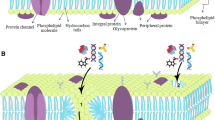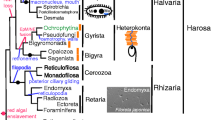Summary
The process of formation from endoplasmic reticulum and transfer to Golgi apparatus of small 50–70 nm transition vesicles has been reconstituted in a cell-free system. Fractions enriched in transition elements derived from part-rough, part-smooth transitional regions of the endoplasmic reticulum were prepared from elongation zones of hypocotyls of etiolated seedlings of soybean and coleoptiles of maize and were compared with those from rat liver. When activated with nucleoside triphosphate, cytosol and an ATP regenerating system, time- and temperature-dependent transfer of membranes to Golgi apparatus acceptor was demonstrated. The fractions enriched in transition elements were radioiodinated with125I by the Bolton-Hunter procedure. Acceptor Golgi apparatus stacks were immobilized to nitrocellulose strips to facilitate analysis. In heterologous transfer experiments, the plant and animal acceptors and donors could be interchanged. The transfer was limited primarily by the donor (rat liver > soybean hypocotyl > maize coleoptiles) and determined secondarily by the source of the acceptor. The acceptor fractions were most efficacious when prepared from the same source as the donor. Thus, 50–70 nm vesicles bud from transitional endoplasmic reticulum elements of plants function in a manner similar to those of animal cells to transfer membrane materials to the Golgi apparatus. The recognition signals that determine vesicle fusion appear to be conserved both among species and between the plant and animal kingdoms to the extent that donor and acceptor sources may be interchanged with only small reductions in overall efficiency of transfer.
Similar content being viewed by others
Abbreviations
- HEPES:
-
N-2-hydroxyethylpiperazine-N′-2-ethanesulfonic acid
- EDTA:
-
ethylenediaminetetraacetic acid
References
Balch WE, Dunphy WG, Braell WA, Rothman JE (1984) Reconstitution of the transport of protein between successive compartments of Golgi measured by the coupled corporation of N-acetyl glucosamine. Cell 39: 405–416
Bolton AE, Hunter WM (1973) The labeling of proteins to high specific radioactivities by conjugation to a125I-containing acylating agent. Biochem J 133: 529–538
Dunphy WG, Rothman JE (1985) Compartmental organization of the Golgi stack. Cell 42: 13–21
Hannig K, Heidrich H-G (1977) Continuous free-flow electrophoresis and its application in biology. In: Bloemendal H (ed) Cell separation methods, part IV, electrophoretic methods, Elsevier/North Holland Biomedical Press, New York, pp 96–116
Lowry OH, Rosebrough NJ, Farr AL, Randall RJ (1951) Protein measurement with the Folin phenol reagent. J Biol Chem 193: 265–275
Luft JM (1961) Improvements in epoxy resin embedding methods. J Biophys Biochem Cytol 9: 409–414
Mollenhauer HH, Hass BS, Morré DJ (1976) Membrane transformations in Golgi apparatus of rat spermatids. A role for thick cisternae and two classes of coated vesicles in acrosome formation. J Microsc Biol Cell (Paris) 27: 33–36
Morré DJ (1971) Isolation of Golgi apparatus. Methods Enzymol 22: 130–148
— (1973) Isolation and purification of organelles and endomembrane components from rat liver. In: Chrispeels MJ (ed) Molecular techniques and approaches in developmental biology. Wiley, New York, pp 1–27
—, Mollenhauer HH, Bracker CE (1971) The origin and continuity of Golgi apparatus. In: Reinert T, Ursprung H (eds) Origin and continuity of cell organelles. Springer, Berlin Heidelberg New York, pp 82–126 [Beerman W et al (eds) Results and problems in cell differentiation, vol 2]
—, Bracker CE, Cheetham RD, Nyquist SE, Ovtracht L (1972) A simplified procedure for isolation of Golgi apparatus from rat liver. Prep Biochem 2: 61–69
—, Morré DM, Heidrich H-G (1983) Subfraction of rat liver Golgi apparatus by free-flow electrophoresis. Eur J Cell Biol 31: 263–274
—, Paulik M, Nowack D (1986) Transition vesicle formation in vitro. Protoplasma 132: 110–113
Nowack DD, Morré DM, Paulick M, Keenan TW, Morré DJ (1987) Intracellular membrane flow: reconstitution of transition vesicle formation and function in a cell-free system. Proc Natl Acad Sci USA 84: 6098–6102
Palade GE (1983) Membrane biogenesis: an overview. Methods Enzymol 69: xxiv-lv
Paquet MR, Pfeffer SR, Burczak JD, Glick BS, Rothman JE (1986) Components responsible for transport between successive Golgi cisternae are highly conserved in evolution. J Biol Chem 261: 4367–4370
Paulik M, Nowack DD, Morré DJ (1988) Isolation of a vesicular intermediate in the cell-free transfer of membrane from transitional elements of the endoplasmic reticulum to Golgi apparatus cisternae of rat liver. J Biol Chem 263: 17738–17748
Author information
Authors and Affiliations
Rights and permissions
About this article
Cite this article
Morré, D.J., Nowack, D.D., Paulik, M. et al. Transitional endoplasmic reticulum membranes and vesicles isolated from animals and plants. Protoplasma 153, 1–13 (1989). https://doi.org/10.1007/BF01322459
Received:
Accepted:
Issue Date:
DOI: https://doi.org/10.1007/BF01322459




